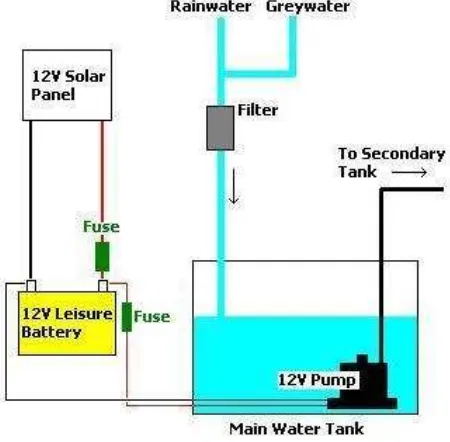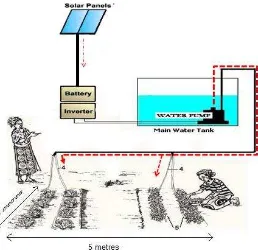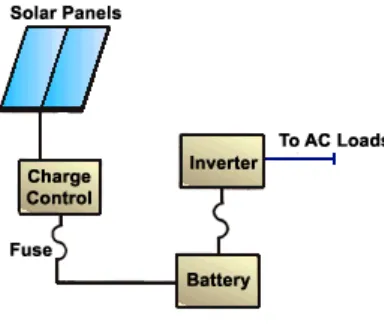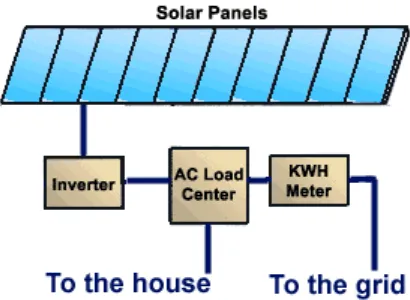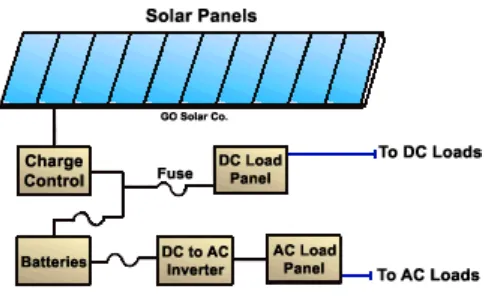i
SOLAR POWERED IRRIGATION
MAIMUNAH AWANG MAJID
This Report Is Submitted In Partial Fulfillment of Requirement for the Degree of Bachelor in Electrical Engineering (Power Industry)
Faculty of Electrical Engineering
UNIVERSITI TEKNIKAL MALAYSIA MELAKA
ii
“I hereby declared that I have read through this report and found that it has comply the partial fulfillment for awarding the degree of Bachelor of Electrical Engineering
(Industrial Power)”
Signature :………
Supervisor’s Name : EN. ALIAS BIN KHAMIS
iii
“I hereby declared that this report is of my own work except for the excerpts that have been cited clearly in the references”
Signature :……….. Name : MAIMUNAH BINTI AWANG MAJID Date :………...
iv
ACKNOWLEDGEMENT
v
ABSTRACT
vi
ABSTRAK
vii
TABLE OF CONTENTS
CHAPTER TITLE PAGE
ACKNOWLEDGEMENT iv
ABSTRACT v
TABLE OF CONTENTS vii
LIST OF TABLES ix
LIST OF FIGURES x
LIST OF ABBREVIATIONS xii
LIST OF APPENDIX xiii
1 INTRODUCTION
1.1 Introduction To Solar 1
1.2 Problem Statement 3
1.3 Objective 3
1.4 Scope 3
1.5 Project Background 4
2 LITERATURE REVIEW
2.1 Solar 5
2.2 Types of Solar Electric Systems 9
2.3 Portable Stand Alone Solar System 13
3.4 Porous Pipe Plot Irrigation 14
2.5 Charge Controllers 15
viii
3 METHODOLOGY
3.1 Project Planning 23
3.2 Flow Chart 24
3.3 Hardware Design 26
3.4 Summary 27
4 THEORITICAL RESEARCH
4.1 Transistor 28
4.2 Sealed Rechargeable Batteries (12V) 32
4.3 Transformers 33
4.4 Water Pump 34
4.5 Summary 35
5 PROJECT DEVELOPMENT
5.1 Develop the DC Main Circuit 36 5.2 Develop the AC circuit 39
5.3 Summary 43
6 RESULT
6.1 System Flow 44 6.2 Solar Voltage and current Reading 45
6.3 Summary 47
7 CONCLUSION
7.1 Discussion 48
7.2 Recommendation 49
7.3 Conclusion 51
REFERENCES 52
ix
LIST OF TABLES
NO TITLE PAGE
2.1 Recommend fuses, breakers and wire for inverter. 21
3.1 Project planning schedules 23
6.1 Solar output reading 45
6.2 Load reading for noon 45
6.3 Load reading for evening 45
x
LIST OF FIGURES
NO TITLE PAGE
1.2 Solar Power Irrigation 2
2.1 Small Stand Alone Systems 9
2.2 Grid-Tie Solar System 10
2.3 Complete Stand-Alone Solar System 11
2.4 Hybrid Solar Electric and Generator Combination System 12
2.5 Portable Stand Alone Solar System 13
2.6 Traditional Irrigation 14
2.7 Porous Pipe 15
2.8 The Sine Wave Inverter 21
3.1 Flow Chart of Project Planning 25
3.2 Complete System of Solar Powered Irrigation 26
4.1 BJT Used As an Electronic Switch 29
4.2 Amplifier Circuit, Standard Common-Emitter Configuration 29
4.3 Simple Circuit Using a Transistor 30
4.4 Operation Graph of a Transistor 30
4.5 The Components of a Transformer 33
4.6 Water Pump 34
5.1 Voltage Waveforms 37
5.2 Direct Current circuit 38
5.3 Simulation of the DC Circuit 38
5.4 Inverter Circuit 39
5.5 An Inverter Circuit 40
5.6 Complete Circuit of Solar Powered Irrigation 41
xi
5.8 Testing Circuit 42
5.9 Solar Panel 43
6.1 Testing Circuit with Solar 46
6.2 Load running 47
7.1 Electronic Water Timer 50
xii
LIST OF ABBREVIATIONS
AC - Alternating Current
DC - Direct Current
PV - Photovoltaic
TNB - Tenaga Nasional Berhad
EVA - Ethylene vinyl acetate
UPS - Uninterruptible power supply
BJT - Bipolar junction transistors
FET - Field-effect transistors
CCA - Cold cranking ability
xiii
LIST OF APPENDIXS
NO TITLE PAGE
A Project Planning 55
1
CHAPTER 1
INTRODUCTION
1.1 Introduction To Solar
Solar power is absolutely perfect for use with irrigation systems for gardens, allotments, greenhouses and polytunnels. When the sun is shining you need more water and so the solar power is there for the pump. By adding a suitable deep-cycle battery, power can be made available 24 hours per day enabling watering in the evening which is the best time to water plants in the summer so that the water has a chance to soak into the ground. A main water tank is used to store rainwater runoff from roofs and grey water from where it is pumped to a secondary tank when and where it is needed. The secondary tank can be placed at ground level and used to fill watering cans or in a slightly elevated position to gravity feed water through porous pipe or leaky pipe irrigation.
A typical solar irrigation system is made up of the following components:
PV Solar Panel
Deep cycle battery
12V Pump
2
An automated irrigation system can be put together using a suitable 12V programmable timer or mechanical timer which will turn on the pump at the same time every morning and evening. The timer will turn on or off the circuit each day. To protect the pump from being damaged if it runs out of water to pump and to prevent any secondary tanks from overflowing, float switches can be used to detect water levels and their readings fed into the electronic controller. The solar powered irrigation is illustrated as shown in figure below.
Figure 1.1: Solar Power Irrigation
1.2 Problem Statement
3
1.3 Objective
There are many main objective of doing this project. The main purpose of this project is to design and develop solar powered water pump combines the knowledge of electrical and electronic which is replaced the other technique to irrigate garden with the efficient and consistent equipment. The main objectives of this project are:
To design the water pump powered by solar circuit, inverter and DC supply.
To develop the circuit of the solar power irrigation.
To simulate the circuit by using the proteus and multisim software.
To test the circuit by using portable stand alone solar panel at energy efficiency lab.
To provide a back-up power when the power from the solar is not available by using deep-cycle battery.
1.4 Scope
4
Figure 1.2: The Area That Covered By Solar Powered Irrigation
1.5 Project Background
5
CHAPTER 2
LITERATURE REVIEW
This chapter is consists of explanation and review of past projects that have been done before. It is consists of the products in the market and in industrial field. Beside that, this chapter also consists about the theory of component, equipment and energy that is used in this project.
2.1 Solar
Electricity generated by solar panels is referred to as photovoltaic. The photovoltaic produces electricity directly from sunlight with a solar panel made of semiconductor material. The power provided is direct current. The basic building block is known as a cell. Many cells put together are known as a module and many modules assembled together from an array. A PV system will consist of an array of modules generating DC electricity, an inverter and sometimes battery storage back-up with charge controller. [4]
6
generated and this can be conducted away by metal contacts as direct current. The electrical output from a single cell is small, so multiple cells are connected together and formed to modules.
There are two kinds of electricity, DC and AC. Homes that are connected to utility power using AC electricity. Flashlights, small radios and automobiles use direct current electricity. In order to be able to use solar to operate the appliances in home, an inverter will convert PV power from DC to AC. Inverters can be further classified as units that use batteries. The amount of power produced will depend upon how large the system.
Types of solar:
Solar power system
Solar electric system
Renewable solar energy
Renewable electricity Benefits of renewable solar energy:
Renewable solar energy does not deplete earth’s natural resources.
Renewable solar energy is dependable, affordable and easy to distribute, simple to connect to existing electrical grids.
Renewable solar energy allows lock-in long term electricity rates, putting in control even if on-grid utility prices solar.
Solar systems are reliable, attractive and affordable.
Advantages of photovoltaic solar power
Photovoltaic solar power is one of the most promising renewable energy sources in the world. Compared to non-renewable sources such as coal, gas, oil, and nuclear, the advantages are clear:
Generates free energy from the sun.
Have no moving parts to break down thus requiring minimal maintenance.
7
Photovoltaic cells are modular
Systems have a long life and durability, the cells life time is about 25 to 35 years.
Grid tie systems allowing selling excess electricity back to the utilities.
Can be installed and operated anywhere including areas of difficult access and remote locations.
Helps from dependence on foreign oil.
PV cells make no noise and give off no exhaust.
Allow the use of electricity in remote areas where it would be expensive or impossible to run power lines.
Have electrical power during blackouts.
Solar energy is the radiant light and heat from the Sun that has been harnessed by humans since ancient times using a range of ever-evolving technologies. Solar radiation along with secondary solar resources such as wind and wave power, hydroelectricity and biomass account for most of the available renewable energy on Earth. Only a minuscule fraction of the available solar energy is used.
Solar power technologies provide electrical generation by means of heat engines or photovoltaic. Once converted its uses are only limited by human ingenuity. A partial list of solar applications includes space heating and cooling through solar architecture, portable water via distillation and disinfection, day lighting, hot water, thermal energy for cooking and high temperature process heat for industrial purposes.
Solar technologies are broadly characterized as either passive solar or active solar depending on the way they capture, convert and distribute sunlight. Active solar techniques include the use of photovoltaic panels, solar thermal collectors, with electrical or mechanical equipment, to convert sunlight into useful outputs. Passive solar techniques include orienting a building to the sun, selecting materials with favorable thermal mass or light dispersing properties and designing spaces that naturally circulate air.
8
that has been use. From the literature review, the analysis can be done for this solar powered irrigation.
A photovoltaic array is a linked collection of photovoltaic modules, which are in turn made of multiple interconnected solar cells. The cells convert solar energy into direct current electricity via the photovoltaic effect. The power that one module can produce is seldom enough to meet requirements of a home or a business, so the modules are linked together to form an array.
Most PV arrays use an inverter to convert the DC power produced by the modules into alternating current that can plug into the existing infrastructure to power lights, motors and other loads. The modules in a PV array are usually first connected in series to obtain the desired voltage, the individual strings are then connected in parallel to allow the system to produce more current. Solar arrays are typically measured by the peak electrical power they produce, in watts, kilowatts or even megawatts.
A solar electric panel, often called a PV panel is basically a set of treated silicon cells arranged in a series string that produces electric power when exposed to light. There are four common types of solar panels manufactured:
Monocrystalline - made from a single large crystal, cut from ingots. Most efficient, but also the most expensive. Somewhat better in low light conditions, but not as good as some advertising hype.
Polycrystalline - basically, cast blocks of silicon which may contain many small crystals. This is probably the most common type right now. Slightly less efficient than single crystal, but once set into a frame with 35 or so other cells, the actual difference in watts per square foot is not much.
Amorphous - thin film silicon is spread directly on large plates, usually of something like stainless steel. Cheaper to produce, but often much less efficient, which means larger panels for the same power. Unisolar is the one example.
9
For all practical purposes, how the four types of solar work in applications are very similar. Its will all do the same thing which is make electricity when the sun hits it. Thin film solar panels are often less efficient, so it will take up more room for the same power, but on the other hand it’s often cheaper per watt. Crystalline panels are almost always more efficient in converting sunlight to power, so take up less room. They are usually somewhat more expensive than amorphous panels, but often the installation costs will be less because much less hardware is required.
2.2 Types of Solar Electric Systems 2.2.1 Small Stand-Alone Systems
Figure 2.1: Small Stand Alone Systems
10
2.2.2 Grid-tie Solar Systems
Figure 2.2: Grid-Tie Solar System
11
2.2.3 Complete Stand-Alone Solar System
Figure 2.3: Complete Stand-Alone Solar System
